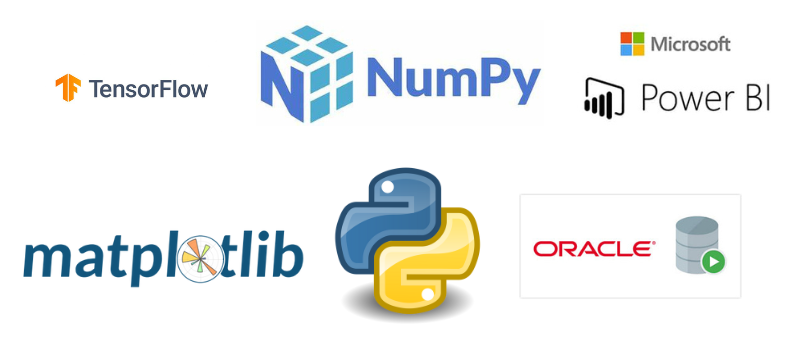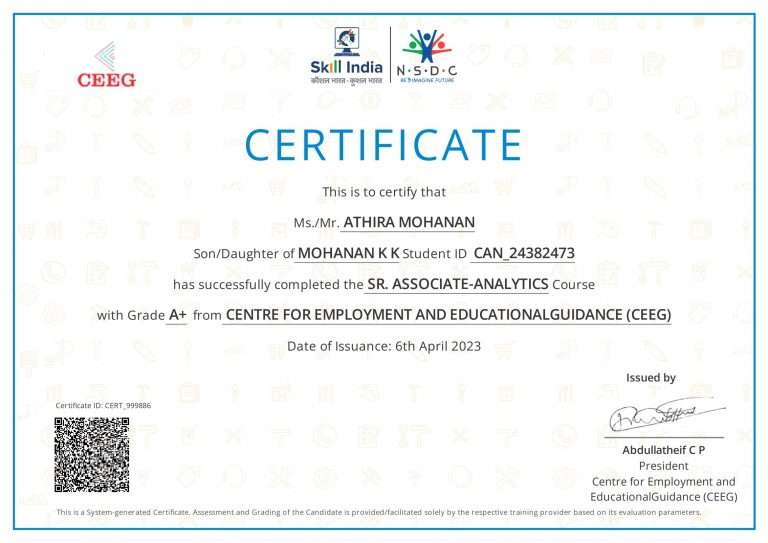
Data Analytics
Curriculum
-
Introduction to Oracle Database :
-
List the features of Oracle Database 11g
-
Save queries to files and use script files in SQL Developer
-
Retrieve Data using the SQL SELECT Statement
-
List the capabilities of SQL SELECT statements
-
Generate a report of data from the output of a basic SELECT statement
-
Select All Columns
-
Select Specific Columns
-
Use Arithmetic Operators
-
Understand Operator Precedence
-
Learn the DESCRIBE command to display the table structure
-
Learn to Restrict and Sort Data
-
Write queries that contain a WHERE clause to limit the output retrieved
-
Describe the rules of precedence for comparison and logical operators
-
Sort output in descending and ascending order
-
Manipulate numbers with the ROUND, TRUNC, and MOD functions
-
Perform arithmetic with date data
-
Manipulate dates with the DATE functions
-
Invoke Conversion Functions and Conditional Expressions
-
Describe implicit and explicit data type conversion
-
Use the TO_CHAR, TO_NUMBER, and TO_DATE conversion functions
-
Aggregate Data Using the Group Functions
-
Use the aggregation functions in SELECT statements to produce meaningful reports
-
Divide the data in groups by using the GROUP BY clause
-
Exclude groups of date by using the HAVING clause
-
Display Data From Multiple Tables Using Joins
-
Write SELECT statements to access data from more than one table
-
View data that generally does not meet a join condition by using outer joins
-
Cross Join
-
Equi Join
-
Non Equi Join
-
Outer Join
-
Left outer Join
-
Right Outer Join
-
Data Manipulation Statements
-
Describe each DML statement
-
Insert rows into a table
-
Change rows in a table by the UPDATE statement
-
Delete rows from a table with the DELETE statement
-
Save and discard changes with the COMMIT and ROLLBACK statements
-
Explain read consistency
-
Categorize the main database objects
-
Review the table structure
-
List the data types available for columns
-
Create a simple table
-
Decipher how constraints can be created at table creation
-
Describe how schema objects work
-
Use of DDL Statements to Create and Manage Tables
-
Control User Access
-
Differentiate system privileges from object privileges
-
Create Users
-
Create and Grant Privileges to a Role
-
Change Your Password
-
Grant Object Privileges
-
How to pass on privileges?
-
Revoke Object Privileges
-
Microsoft Excel Basics
-
Python Training Modules
-
Introduction
-
Data Types & Variables
-
Python Operators
-
Python Strings
-
Python Lists
-
Python Tuples
-
Python Sets
-
Python Dictionary
-
If Else Statement
-
While Loop
-
For Loop
-
Functions
-
Recursions
-
Lambda
-
Object Oriented Programming
-
Inheritance(OOP)
-
Math Functions
-
Python Modules
-
Python Modules
-
File Handling
-
JSON
-
Pandas
-
Numpy
-
Advance OOPS Concept
-
Abstract
-
Polymorphism
-
Encapsulation
-
Database Connectivity Using(Pandas)&(Psycopg)
-
Server side scripting
-
Data Frame
-
Matplotlib
-
SciPy
-
JupyterNote
-
Microsoft Power BI Desktop Visualisation
-
Business Intelligence Basics
-
What is BI ?
-
Different BI Tools
-
Advantages of BI
-
Applications and Future of BI
-
Overview of BI and Data Integration Products
-
Opportunities/ Scope of BI
-
What is a Data Warehouse?
-
Data Warehousing Schemas
-
Dimensions and Fact Table types
-
Modeling Types
-
Star and Snow Flake Examples and differences
-
PBI Architecture Overview
-
Microsoft Power BI Desktop
-
Overview of Power BI
-
Introduction to Tools and Terminology.
-
Different components of PBI
-
Downloading and installation of PBI Desktop
-
An overview of the interface
-
Introducing 3 views of PBI
-
Different connection options
-
Connecting to Microsoft Excel
-
Connecting to Oracle Database
-
Connecting to CSV files
-
Different method of extracting data
-
Power Query Editor (ETL Tool)
-
Overview of Power Query Editor (cleaning up messy data)
-
Transform Data
-
Pivot and Unpivot tables
-
Adding columns
-
Text functions
-
Number functions
-
Date and Time functions
-
Grouping Data
-
Data Profiling
-
Create custom date table using MCode Method
-
Combining schemas for modeling
-
Refreshing Option
-
Visualization and report
-
Overview: Visualizations
-
Using visualizations
-
Overview: Power BI data sources
-
Upload Power BI data sources
-
Basic charts in Power BI
-
Creating basic visuals
-
Formatting visuals and pages
-
Using Themes and Import Custom Themes from Gallery.
-
Inserting images to our report
-
How to set up your data model – Setup and Manage relationships
-
Sort, copy, and paste visualizations
-
Creating hierarchy
-
Grouping data
-
Setting interactions between visuals
-
Using Various types of graphs
-
Using Slicers to filter the data.
-
Using Filters
-
Using Tool Tips at Page Level and Field Level
-
Conditional Formatting in Tables and Graphs.
-
Parameter settings
-
Using Buttons and Actions
-
Creating Bookmarks with Various actions
-
Selection option
-
Ask a Questions to create Custom visuals by Using Q&A
-
Familiarizing different AI visuals
-
Using Market Place to add Custom visuals to Visualizations
-
Use Scrollers and Hierarchy Slicers from Market Place
-
Download and use different custom visuals from the gallery
-
Sample Reports using Database Tables
-
DAX
-
What is DAX?
-
Why we use DAX?
-
Basic DAX functions :- SUM, SUMX, CALCULATE…..
-
Time intelligence functions :- SAMEPERIODLASTYEAR, DATEADD
-
Text functions :- CONTAINS, STARTSWITH, ENDSWITH…
-
Mathematical functions :- DIFF, DIVIDE…
-
Aggregate functions :- MIN, MAX, AVG
-
Logical functions :- IF, OR, AND, NOT
-
Count functions :- COUNT, DISTINCTCOUNT
-
Information functions :-ODD, EVEN, RANKX
-
Filter functions :- FILTER, ALL, ALLSELECTED
-
Inter and Intra column operation :- RELATED,SUMMARIZE,SUMMRIZECOULMN
-
Data handling with tables
-
Variables
-
Conditional operation
-
Visualizing DAX Calculations.
-
Difference between Measures and Quick Measures
-
How to organize all the measures
-
Reports and Dashboards
-
How to save a report
-
Modify and Print a Report
-
Rename, hide and delete report pages
-
Send a report to PowerPoint
-
Introducing Power BI Service
-
Publish reports to Power BI Service
-
Creating Dashboards
-
Create and manage dashboards
-
Pin a report tile to a dashboard
-
Pin a live report page to a dashboard
-
Pin a tile from another dashboard
-
Build a dashboard with Quick Insights
-
Interacting with your Dashboards
-
Sharing Dashboards and Reports.
-
Manage published reports
-
Updating report options
-
Advanced Topics
-
Calculated Columns
-
Calculated Tables
-
Variables
-
KPI visual
-
ArcGIS maps
-
AI Visuals
-
Analytics Pane
-
Performance Analyser
-
RLS / Data Level Security and OLS (Overview Tabular)
-
Integration with Python and R – Overview
-
Introduction to Oracle Database :
- List the features of Oracle Database 11g
- Save queries to files and use script files in SQL Developer
- Retrieve Data using the SQL SELECT Statement
- List the capabilities of SQL SELECT statements
- Generate a report of data from the output of a basic SELECT statement
- Select All Columns
- Select Specific Columns
- Use Arithmetic Operators
- Understand Operator Precedence
- Learn the DESCRIBE command to display the table structure
- Learn to Restrict and Sort Data
- Write queries that contain a WHERE clause to limit the output retrieved
- Describe the rules of precedence for comparison and logical operators
- Sort output in descending and ascending order
- Manipulate numbers with the ROUND, TRUNC, and MOD functions
- Perform arithmetic with date data
- Manipulate dates with the DATE functions
- Invoke Conversion Functions and Conditional Expressions
- Describe implicit and explicit data type conversion
- Use the TO_CHAR, TO_NUMBER, and TO_DATE conversion functions
- Aggregate Data Using the Group Functions
- Use the aggregation functions in SELECT statements to produce meaningful reports
- Divide the data in groups by using the GROUP BY clause
- Exclude groups of date by using the HAVING clause
- Display Data From Multiple Tables Using Joins
- Write SELECT statements to access data from more than one table
- View data that generally does not meet a join condition by using outer joins
- Cross Join
- Equi Join
- Non Equi Join
- Outer Join
- Left outer Join
- Right Outer Join
- Data Manipulation Statements
- Describe each DML statement
- Insert rows into a table
- Change rows in a table by the UPDATE statement
- Delete rows from a table with the DELETE statement
- Save and discard changes with the COMMIT and ROLLBACK statements
- Explain read consistency
- Categorize the main database objects
- Review the table structure
- List the data types available for columns
- Create a simple table
- Decipher how constraints can be created at table creation
- Describe how schema objects work
- Use of DDL Statements to Create and Manage Tables
- Control User Access
- Differentiate system privileges from object privileges
- Create Users
- Create and Grant Privileges to a Role
- Change Your Password
- Grant Object Privileges
- How to pass on privileges?
- Revoke Object Privileges
-
Microsoft Excel Basics
-
Python Training Modules
- Introduction
- Data Types & Variables
- Python Operators
- Python Strings
- Python Lists
- Python Tuples
- Python Sets
- Python Dictionary
- If Else Statement
- While Loop
- For Loop
- Functions
- Recursions
- Lambda
- Object Oriented Programming
- Inheritance(OOP)
- Math Functions
- Python Modules
- Python Modules
- File Handling
- JSON
- Pandas
- Numpy
- Advance OOPS Concept
- Abstract
- Polymorphism
- Encapsulation
- Database Connectivity Using(Pandas)&(Psycopg)
- Server side scripting
- Data Frame
- Matplotlib
- SciPy
- JupyterNote
-
Microsoft Power BI Desktop Visualisation
- Business Intelligence Basics
- What is BI ?
- Different BI Tools
- Advantages of BI
- Applications and Future of BI
- Overview of BI and Data Integration Products
- Opportunities/ Scope of BI
- What is a Data Warehouse?
- Data Warehousing Schemas
- Dimensions and Fact Table types
- Modeling Types
- Star and Snow Flake Examples and differences
- PBI Architecture Overview
- Microsoft Power BI Desktop
- Overview of Power BI
- Introduction to Tools and Terminology.
- Different components of PBI
- Downloading and installation of PBI Desktop
- An overview of the interface
- Introducing 3 views of PBI
- Different connection options
- Connecting to Microsoft Excel
- Connecting to Oracle Database
- Connecting to CSV files
- Different method of extracting data
- Power Query Editor (ETL Tool)
- Overview of Power Query Editor (cleaning up messy data)
- Transform Data
- Pivot and Unpivot tables
- Adding columns
- Text functions
- Number functions
- Date and Time functions
- Grouping Data
- Data Profiling
- Create custom date table using MCode Method
- Combining schemas for modeling
- Refreshing Option
- Visualization and report
- Overview: Visualizations
- Using visualizations
- Overview: Power BI data sources
- Upload Power BI data sources
- Basic charts in Power BI
- Creating basic visuals
- Formatting visuals and pages
- Using Themes and Import Custom Themes from Gallery.
- Inserting images to our report
- How to set up your data model – Setup and Manage relationships
- Sort, copy, and paste visualizations
- Creating hierarchy
- Grouping data
- Setting interactions between visuals
- Using Various types of graphs
- Using Slicers to filter the data.
- Using Filters
- Using Tool Tips at Page Level and Field Level
- Conditional Formatting in Tables and Graphs.
- Parameter settings
- Using Buttons and Actions
- Creating Bookmarks with Various actions
- Selection option
- Ask a Questions to create Custom visuals by Using Q&A
- Familiarizing different AI visuals
- Using Market Place to add Custom visuals to Visualizations
- Use Scrollers and Hierarchy Slicers from Market Place
- Download and use different custom visuals from the gallery
- Sample Reports using Database Tables
- DAX
- What is DAX?
- Why we use DAX?
- Basic DAX functions :- SUM, SUMX, CALCULATE…..
- Time intelligence functions :- SAMEPERIODLASTYEAR, DATEADD
- Text functions :- CONTAINS, STARTSWITH, ENDSWITH…
- Mathematical functions :- DIFF, DIVIDE…
- Aggregate functions :- MIN, MAX, AVG
- Logical functions :- IF, OR, AND, NOT
- Count functions :- COUNT, DISTINCTCOUNT
- Information functions :-ODD, EVEN, RANKX
- Filter functions :- FILTER, ALL, ALLSELECTED
- Inter and Intra column operation :- RELATED,SUMMARIZE,SUMMRIZECOULMN
- Data handling with tables
- Variables
- Conditional operation
- Visualizing DAX Calculations.
- Difference between Measures and Quick Measures
- How to organize all the measures
- Reports and Dashboards
- How to save a report
- Modify and Print a Report
- Rename, hide and delete report pages
- Send a report to PowerPoint
- Introducing Power BI Service
- Publish reports to Power BI Service
- Creating Dashboards
- Create and manage dashboards
- Pin a report tile to a dashboard
- Pin a live report page to a dashboard
- Pin a tile from another dashboard
- Build a dashboard with Quick Insights
- Interacting with your Dashboards
- Sharing Dashboards and Reports.
- Manage published reports
- Updating report options
- Advanced Topics
- Calculated Columns
- Calculated Tables
- Variables
- KPI visual
- ArcGIS maps
- AI Visuals
- Analytics Pane
- Performance Analyser
- RLS / Data Level Security and OLS (Overview Tabular)
- Integration with Python and R – Overview










